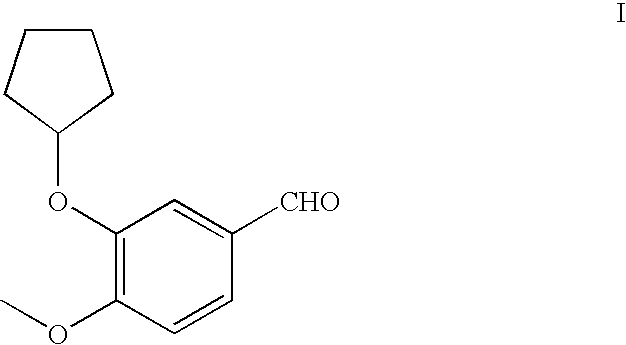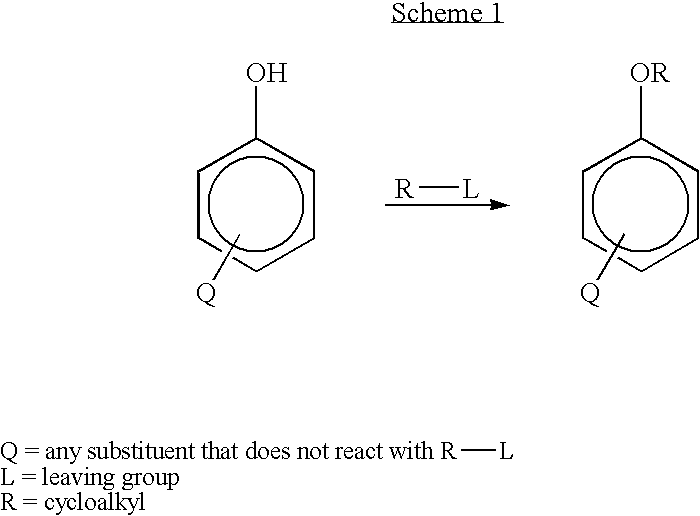Method for preparing 3-cyclopentyloxy-4-methoxybenzaldehyde
a technology of cyclopentyloxy and benzaldehyde, which is applied in the field of preparing 3cyclopentyloxy4methoxybenzaldehyde, can solve the problems that the solvents utilized during isovanillin alkylation are also incompatible with the reagents used in certain subsequent reactions
- Summary
- Abstract
- Description
- Claims
- Application Information
AI Technical Summary
Benefits of technology
Problems solved by technology
Method used
Image
Examples
example 1
Preparation of 3-Cyclopentyloxy-5-Methoxybenzaldehyde
[0057]A 1-L flask equipped with a mechanical stirrer, nitrogen inlet, thermometer, and condenser, were charged with isovanillin (91.2 g, 0.60 mol, 1.0 equivalent) and THF (250 mL), followed by addition of Bu4NBr (19.3 g, 0.06 mol, 10 mol%, 0.10 eq.) and anhydrous K2CO3 (124 g, 0.90 mol, 1.5 eq.). The reaction mixture was stirred vigorously and heated to reflux (about 65 to about 75° C.). Cyclopentyl bromide (89.4 g, 0.60 mol, 1.0 eq.) was added dropwise and the mixture was stirred at refluxed for 6 hours. A second portion of cyclopentyl bromide (44.7 g, 0.30 mol, 0.5 eq.) was added dropwise and stirring and heating was continued for 6 hours. The reaction solution was monitored by TLC for completion, thereby cooled to room temperature, and any remaining solids removed by filtration. The filter pad was washed with THF (2×90 mL) to remove remaining 3-cyclopentyloxy-5-methoxybenzaldehyde on the filter pad. 3-Cyclopentyloxy-5-methoxyb...
example 2
Preparation of 1-(3-Cyclopentyloxy-4-Methoxyphenyl)Ethanol
[0058]To the 3-cyclopentyloxy-4-methoxybenzaldehyde in THF solution from Example 1, 3 M methyl magnesium chloride in THF (240 mL) was added dropwise at −10 to -4° C. over 5 hours. After stirring an additional 1 hour at 0° C., HPLC showed 0.07% aldehyde remaining. The reaction mixture was slowly treated with 20% ammonium chloride (340 g) and then acidified with 10% hydrochloric acid (270 g) to a pH of 8. The layers were separated, the aqueous layer extracted with THF, and the combined extracts washed with brine. The organic solution was concentrated to give 1-(3-cyclopentyloxy-4-methoxyphenyl) ethanol as an oil (115.05 g, 81% yield, purity 94.4% by HPLC area). 1H-NMR: 6.93 (d, J=1.8 Hz, 1H), 6.88 (dd, J=8.2 Hz, J=1.8 Hz, 1H), 6.83 (d, J=8.2, 1H), 4.80 (m, 2H), 3.84 (s, 3H), 1.99–1.80 (m, 6H), 1.61 (m, 2H), and 1.48 (d, J=6.4 Hz, 3H). 13C-NMR: 149.2, 147.6, 138.5, 117.5, 112.3, 111.7, 80.3, 70.0, 56.0, 32.7, 25.0, and 24.0.
example 3
Preparation of (3-Cyclopentyloxy-4-Methoxyphenyl)Methanol
[0059]1M lithium aluminum hydride in THF (1.5 mL) was added into a stirred solution of 3-cyclopentyloxy-4-methoxybenzaldehyde (1.1 g; 5 mmol) in THF solution in an ice bath. After the reaction was completed (as evidenced by TLC), the mixture was acidified with 2M HCl and extracted with ether. The organic phase was washed with water and dried over MgSO4. Filtration, followed by evaporation gave (3-cyclopentyloxy-4-methoxyphenyl)methanol as an oil ( 0.9 g; 81% yield; purity 98.1% by HPLC area). 1H-NMR: 6.92 (s, 1H), 6.88 (d, J=8.2 Hz, 1H), 6.84 (d, J=8.1 Hz, 1H), 4.80 (m, 1H), 4.61 (s, 2H), 3.84 (s, 3H), 2.13–1.78 (m, 6H), and 1.61 (s, 2H). 13C-NMR: 149.4, 147.6, 133.6, 119.3, 114.0, 111.7, 80.3, 60.5, 56.0, 32.7, and 24.0.
PUM
| Property | Measurement | Unit |
|---|---|---|
| pH | aaaaa | aaaaa |
| phase transfer | aaaaa | aaaaa |
| boiling point | aaaaa | aaaaa |
Abstract
Description
Claims
Application Information
 Login to View More
Login to View More - R&D
- Intellectual Property
- Life Sciences
- Materials
- Tech Scout
- Unparalleled Data Quality
- Higher Quality Content
- 60% Fewer Hallucinations
Browse by: Latest US Patents, China's latest patents, Technical Efficacy Thesaurus, Application Domain, Technology Topic, Popular Technical Reports.
© 2025 PatSnap. All rights reserved.Legal|Privacy policy|Modern Slavery Act Transparency Statement|Sitemap|About US| Contact US: help@patsnap.com



